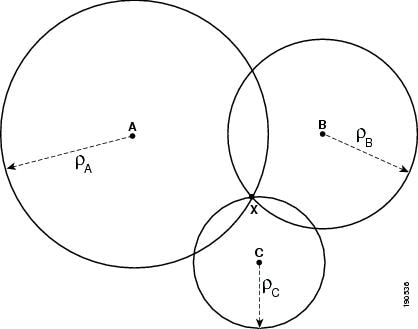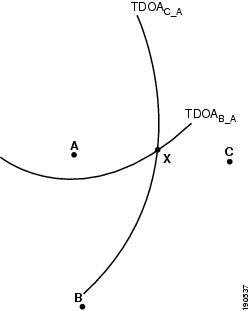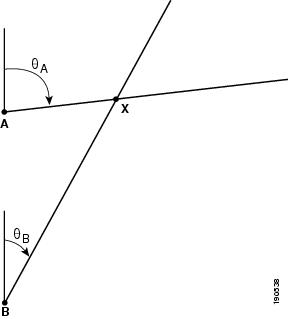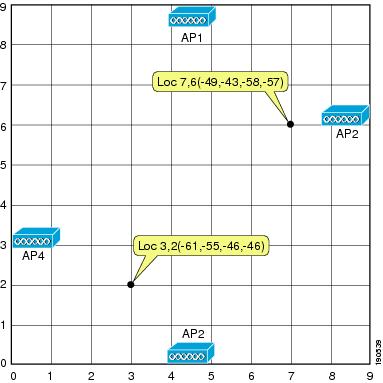Table Of Contents
Location Tracking Approaches
Cell of Origin
Distance-Based (Lateration) Techniques
Time of Arrival
Time Difference of Arrival (TDoA)
Received Signal Strength (RSS)
Angle-Based (Angulation) Techniques
Angle of Arrival (AoA)
Location Patterning (Pattern Recognition) Techniques
Calibration Phase
Operational Phase
Location Tracking Approaches
Location tracking and positioning systems can be classified by the
measurement techniques they employ to determine mobile device location (localization).
These approaches differ in terms of the specific technique used to
sense and measure the position of the mobile device in the target
environment under observation. Typically, Real Time Location Systems (RTLS) can be grouped into four basic categories of systems that determine position on the basis of the following:
•

Cell of origin (
nearest cell)
•

Distance (
lateration)
•

Angle (
angulation)
•

Location patterning
(pattern recognition)
An RTLS designer can choose to implement one or more of these
techniques. This may be clearly seen in some approaches that attempt to
optimize performance in two or more environments with very different
propagation characteristics. The popularity of this approach is such
that it is often not unusual to hear arguments supporting the case for a
fifth category that encompasses RTLS offerings that sense and measure
position using a combination of at least two of these methods.
Keep in mind that regardless of the underlying positioning technology,
the "real-time" nature of an RTLS is only as real-time as its most
current timestamps, signal strength readings, or angle-of-incidence
measurements. The timing of probe responses, tag transmissions, and
location server polling intervals can introduce discrepancies between
the actual and reported device position observed during each reporting
interval.
Cell of Origin
One of the simplest mechanisms of estimating approximate location in any
system based on RF "cells" is the concept of cell-of-origin (or
"associated access point" in Wi-Fi 802.11 systems), as shown in Figure 2-1.
Figure 2-1 Cell of Origin
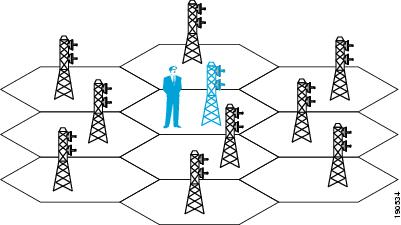
In its simplest form, this technique makes no explicit attempt to
resolve the position of the mobile device beyond indicating the cell
with which the mobile device is (or has been) registered. When applied
to 802.11 systems, this technique tracks the cell to which a mobile
device associates. The primary advantage of this technique is ease of
implementation. Cell of origin does not require the implementation of
complicated algorithms and thus positioning performance is very fast.
Almost all cell-based WLANs and other cellular-based RF systems can be
easily and cost-effectively adapted to provide cell of origin
positioning capability. However, the overwhelming drawback of pure cell
of origin positioning approaches continues to be coarse granularity. For
various reasons, mobile devices can be associated to cells that are not
in close physical proximity, despite the fact that other nearby cells
would be better candidates. This coarse granularity can be especially
frustrating when attempting to resolve the actual location of a mobile
device in a multi-story structure where there is considerable
floor-to-floor cell overlap.
To better determine which areas of the cell possess the highest
probability of containing the mobile device, some additional method of
resolving location within the cell is usually required. This can either
be a manual method (such as a human searching the entire cell for the
device) or a computer-assisted method. When receiving cells provide received signal strength indication (RSSI) for mobile devices, the use of the highest signal strength technique
can improve location granularity over the cell of origin. In this
approach, the localization of the mobile device is performed based on
the cell that detects the mobile device with the highest signal
strength. This is shown in Figure 2-2,
where the blue rectangular client device icon is placed nearest the
cell that has detected it with the highest signal strength.
Figure 2-2 Highest Signal Strength Technique
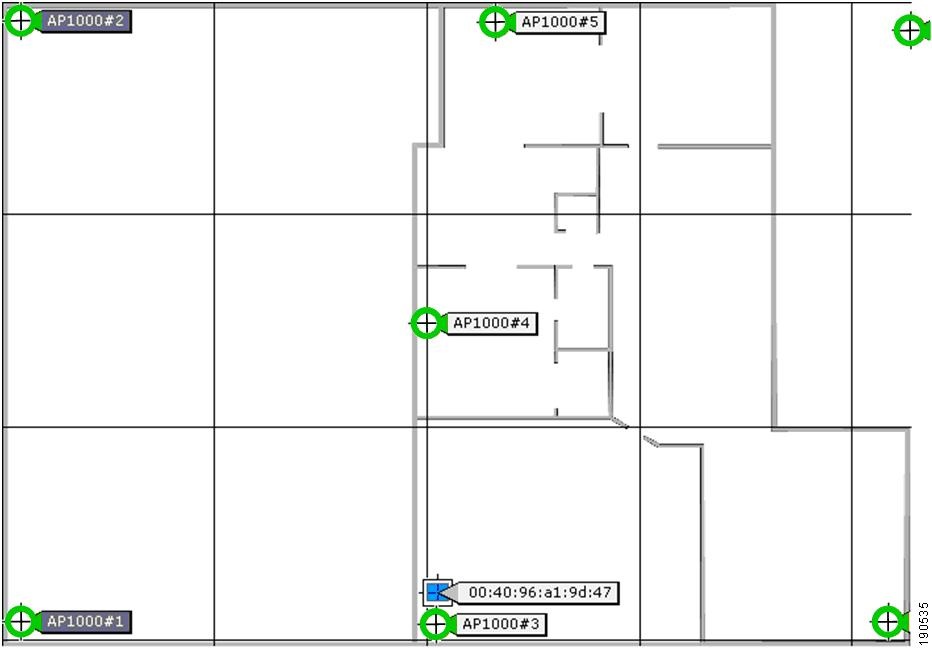
Using this technique, the probability of selecting the true "nearest
cell" is increased over that seen with pure cell of origin. Depending on
the accuracy requirements of the underlying business application,
performance may be more than sufficient for casual location of mobile
clients using the highest signal strength technique. For instance, users
intending to use location-based services only when necessary to help
them find misplaced client devices in non-mission critical situations
may be very comfortable with the combination of price and performance
afforded by solutions using the highest signal strength approach.
However, users requiring more precise location would find the inability
of the highest signal strength technique to isolate the location of a
mobile device with finer granularity than that of an entire coverage
cell to be a serious limitation. These users are better served by those
approaches using the techniques of lateration, angulation, and location
patterning that provide finer resolution and improved accuracy. These
techniques are discussed in subsequent sections.
Distance-Based (Lateration) Techniques
Time of Arrival
Time of Arrival (ToA)
systems are based on the precise measurement of the arrival time of a
signal transmitted from a mobile device to several receiving sensors.
Because signals travel with a known velocity (approximately the speed of
light (c)
or ~300 meters per microsecond), the distance between the mobile device
and each receiving sensor can be determined from the elapsed
propagation time of the signal traveling between them. The ToA technique
requires very precise knowledge of the transmission start time(s), and
must ensure that all receiving sensors as well as the mobile device are
accurately synchronized with a precise time source.
From knowledge of both propagation speed and measured time, it is possible to calculate the distance (D) between the mobile device and the receiving station:
D = c (t)
where:
•
 D
D= distance (meters)
•
 c
c = propagation speed of ~ 300 meters / microsecond
•
 t
t = time in microseconds
With distance used as a radius, a circular representation of the area
around the receiving sensor can be constructed for which the location of
the mobile device is highly probable. ToA information from two sensors
resolves a mobile device position to two equally probable points. ToA tri-lateration makes use of three sensors to allow the mobile device location to be resolved with improved accuracy.
Figure 2-3
illustrates the concept of ToA tri-lateration. The amount of time
required for a message transmitted from station X to arrive at receiving
sensors A, B, and C is precisely measured as tA, tB, and tC. Given a known propagation velocity (stated as c), the mobile device distance from each of these three receiving sensors can then be calculated as DA, DB, and DC, respectively.
Each calculated distance value is used to construct a circular plot
around the respective receiving sensor. From the individual perspective
of each receiver, station X is believed to reside somewhere along this
plot. The intersection of the three circular plots resolves the location
of station X as illustrated in Figure 2-3.
In some cases, there may be more than one possible solution for the
location of mobile device station X, even when using three remote
sensors to perform tri-lateration. In these cases, four or more
receiving sensors are employed to perform ToA multi-lateration.
Figure 2-3 Time of Arrival (ToA)
ToA techniques are capable of resolving location in two-dimensional as
well as three-dimensional planes. 3D resolution can be performed by
constructing spherical instead of circular models.
A drawback of the ToA approach is the requirement for precise time
synchronization of all stations, especially the mobile device (which can
be a daunting challenge for some 802.11 client device implementations).
Given the high propagation speeds, very small discrepancies in time
synchronization can result in very large errors in location accuracy.
For example, a time measurement error as small as 100 nanoseconds can
result in a localization error of 30 meters. ToA-based positioning
solutions are typically challenged in environments where a large amount
of multipath, interference, or noise may exist.
The Global Positioning System (GPS) is a example of a well-known ToA system where precision timing is provided by atomic clocks.
Time Difference of Arrival (TDoA)
Time Difference of Arrival (TDoA) techniques use relative
time measurements at each receiving sensor in place of absolute time
measurements. Because of this, TDoA does not require the use of a
synchronized time source at the point of transmission (i.e. the mobile
device) in order to resolve timestamps and determine location. With
TDoA, a transmission with an unknown starting time is received at
various receiving sensors, with only the receivers requiring time
synchronization.
TDoA implementations are rooted upon a mathematical concept known as hyperbolic lateration. In this approach, at least three time-synchronized receiving sensors are required. In Figure 2-4, assume that when station X transmits a message, this message arrives at receiving sensor A with time TA and at receiving station B with time TB.
The time difference of arrival for this message is calculated between
the locations of sensors B and A as the positive constant k, such that:
TDoAB-A = | TB - TA | = k
The value of TDoAB-A
can be used to construct a hyperbola with foci at the locations of both
receiving sensors A and B. This hyperbola represents the locus of all
the points in the x-y plane, the difference of whose distances from the
two foci is equal to k(c) meters. Mathematically, this represents all possible locations of mobile device X such that:
| DXB - DXA | = k(c)
The probable location of mobile station X can then be represented by a
point along this hyperbola. To further resolve the location of station
X, a third receiving sensor at location C is used to calculate the
message time difference of arrival between sensors C and A, or:
TDoAC-A = | TC - TA | = k1
Knowledge of constant k1 allows
for the construction of a second hyperbola representing the locus of
all the points in the x-y plane, the difference of whose distances from
the two foci (that is, the two receiving sensors A and C) is equal to k1(c) meters. Mathematically, this can be seen as representing all possible locations of mobile device X such that:
| DXC - DXA | = k1(c)
Figure 2-4 illustrates how the intersection of the two hyperbolas TDoAC-A and TDoAB-A is used to resolve the position of station X.
Figure 2-4 Time Difference of Arrival (TDoA)
A fourth receiving sensor and third hyperbola may be added as an enhancement to perform TDoA hyperbolic multi-lateration. This may be required to solve for cases where there may be more than one solution when using TDoA hyperbolic tri-lateration.
Modern TDoA system designers have derived methods of coping with local
clock oscillator drift that are intended to avoid the strict requirement
for precision time synchronization of TDoA receivers. For example, time
adjustments can be calculated periodically with regard to a reference
clock source. These clock adjustments can then be used to correct for
offsets from the reference clock elsewhere in the system. In the case of
TDoA receivers that are capable of transmitting packets (for example, a
TDoA receiver that may be integrated into an 802.11 WLAN access point),
another innovative approach may involve the periodic exchange of
"timing" packets between receivers. In this approach, time offsets
between each receiver and a "reference receiver" can be quantized, with
the resulting time adjustment applied accordingly within the system.
Airport ranging systems are a well-known example of TDoA systems in use
today. In the world of cellular telephony, TDoA is also referred to as
Enhanced Observed Time Difference (E-OTD), and in this specific
application offers an outdoor accuracy in that application of about 60
meters in rural areas and 200 meters in RF-heavy urban areas.
ToA and TDoA have several similarities. Both have proven to be highly
suitable for large-scale outdoor positioning systems. In addition, good
results have been obtained from ToA and TDoA systems in semi-outdoor
environments such as amphitheaters and stadiums, as well as contained
outdoor environments such as car rental and new car lots or ports of
entry. Indoors, TDoA systems exhibit their best performance in buildings
that are large and relatively open, with low levels of overall
obstruction and high ceilings that afford large areas of clearance
between building contents and the interior ceiling. It is precisely in
these open, spacious environments that TDoA and ToA-based systems
operate at their peak efficiency and performance.
Received Signal Strength (RSS)
Thus far we have discussed two lateration techniques (ToA and TDoA) that
use elapsed time to measure distance. Lateration can also be performed
by using received signal strength (RSS) in place of time. With this
approach, RSS is measured by either the mobile device or the receiving
sensor. Knowledge of the transmitter output power, cable losses, and
antenna gains as well as the appropriate path loss model allows you to
solve for the distance between the two stations.
The following is an example of a common path loss model used for indoor propagation:
In this model:
•
 PL
PL represents the total
path loss experienced between the receiver and sender in dB. This will typically be a value greater than or equal to zero.
•
 PL1Meter
PL1Meter represents the
reference path loss
in dB for the desired frequency when the receiver-to-transmitter
distance is 1 meter. This must be specified as a value greater than or
equal to zero.
•
 d
d represents the
distance between the transmitter and receiver in meters.
•
 n
n represents the
path loss exponent for the environment.
•
 s
s represents the standard deviation associated with the degree of
shadow fading present in the environment, in dB. This must be specified as a value greater than or equal to zero.
Path loss (PL)
is the difference between the level of the transmitted signal, measured
at face of the transmitting antenna, and the level at of the received
signal, measured at the face of the receiving antenna. Path loss does
not take antenna gains or cable losses into consideration. Path loss
represents the level of signal attenuation present in the environment
due to the effects of free space propagation, reflection, diffraction,
and scattering.
The path loss exponent (n)
indicates the rate at which the path loss increases with distance. The
value of path loss exponent depends on frequency and environment, and
is highly dependent on the degree of obstruction (or "clutter") present
in the environment. Common path loss exponents range from a value of 2
for open free space to values greater than 2 in environments where
obstructions are present. A typical path loss exponent for an indoor
office environment may be 3.5, a dense commercial or industrial
environment 3.7 to 4.0 and a dense home environment might be as high as
4.5.
The standard deviation of shadow fading (s)
represents a measure of signal strength variability, (sometimes
referred to as "noise") from sources that are not accounted for in the
aforementioned path loss equation. This include factors such as
attenuation due to the number of obstructions present, orientation
differences between location receiver antennas and the antennas of
client devices, reflections due to multipath, and so on. Diversity
antenna implementations reduce perceived signal variation due to shadow
fading, and for this reason diversity antennas are almost universally
recommended. In many indoor installations using diversity antennas, the
standard deviation of shadow fading is often seen between 3 and 7 dB.
The generally accepted method to calculate receiver signal strength
given known quantities for transmit power, path loss, antenna gain, and
cable losses is as follows:
RXPWR = TXPWR - LossTX + GainTX - PL + GainRX - LossRX
We can directly substitute our equation for path loss into the equation above. This enables us to solve for distance d as follows:
where the meaning of the terms in the equation above are:
•
 RxPWR
RxPWR represents the detected receive signal strength in dB.
•
 TxPWR
TxPWR represents the transmitter output power in dB.
•
 LossTX
LossTX represents the sum of all transmit-side cable and connector losses in dB.
•
 GainTX
GainTX represents the transmit-side antenna gain in dBi.
•
 LossRX
LossRX represents the sum of all receive-side cable and connector losses in dB.
•
 GainRX
GainRX represents the receive-side antenna gain in dBi.
Note that all of these are to be specified as positive values.
Solving for distance between the receiver and mobile device allows a
circular area to be plotted around the location of the receiver, using
the distance d as
the radius. The location of the mobile device is believed to be
somewhere on this circular plot. As in other techniques, input from
other receivers in other cells (in this case, signal strength
information or RSSI) can be used to perform RSS tri-lateration or RSS multi-lateration to further refine location accuracy.
The signal strength information used to determine position can be obtained from one of two sources:
•

The
network infrastructure reporting the received signal strength at which
it receives mobile device transmissions ("network-side")
•

The mobile device reporting the signal strength at which it receives transmissions from the network ("client-side")
In 802.11 WLANs, the granularity with which RSSI is reported typically
varies from radio vendor to radio vendor. In fact, 802.11 client devices
produced by different silicon manufacturers may report received signal
strength using inconsistent metrics. This can result in degraded and
inconsistent location tracking performance. Location tracking solutions
that utilize "network-side" RSSI measurements avoid this potential
pitfall when supporting mobile devices from various manufacturers, since
all measurement of RSSI is performed at the network infrastructure, not
at the mobile device. This is a straightforward approach and is
approach most often implemented by vendors of RSS lateration solutions,
since a much higher degree of control is typically exercised over
consistency in network infrastructure versus end user client mobile
devices.
Location tracking solutions that rely on "client-side" RSSI measurements
must take extra steps to avoid location inaccuracies that may be due to
inconsistent mobile device hardware. Since it is not realistic to
assume that every mobile device will be provided by the same hardware
vendor, a method of "equalizing" any variations in relation to some
assumed "reference model" is necessary. For example, assume that a
particular positioning system expects to see reported RSSI in a range
from -127dBm to +127dBm in 254 increments of 1 dBm each. Mathematical
compensation will be required if only some mobile devices in the system
can support this expectation (for example, other devices in the system
may only be able to report RSSI in a range from -111dBm to +111 dBm in
74 increments of 3dBm each).
Typically, the responsibility for providing such equalization lies with
the provider of the location solution. It is common to see such
adjustments made through proprietary client software that installed on
each mobile device in order to ensure all mobile devices can be located
with approximate equal consistency.
To date, implementations using RSS lateration have enjoyed a cost
advantage by not requiring specialized hardware at the mobile device or
network infrastructure locations. This makes signal strength-based
lateration techniques very attractive from a cost-performance standpoint
to designers of 802.11-based WLAN systems wishing to offer integrated
lateration-based positioning solutions. However, a known drawback to
"pure" RSS lateration is that propagation anomalies brought about by
anisotropic conditions in the environment may degrade accuracy
significantly. This is due in part because in reality, propagation in
any cell is far from a purely circular pattern based on an ideal path
loss model. "Textbook" theoretical RSS lateration models in their
purest form do not provide for the measurement or consideration of
variations seen within actual sites, typically assuming only well-known
values for path loss and shadow fading.
Pure RSS-based lateration techniques that do not take additional steps
to account for attenuation and multipath in the environment rarely
produce acceptable results except in very controlled situations. This
includes those controlled situations where there is always established
clear line-of-sight between the mobile device and the receiving sensors,
with little attenuation to be concerned other than free-space path loss
and minor impact from multipath.
Angle-Based (Angulation) Techniques
Angle of Arrival (AoA)
The Angle of Arrival (AoA) technique, sometimes referred to as Direction of Arrival (DoA), locates the mobile station by determining the angle of incidence
at which signals arrive at the receiving sensor. Geometric
relationships can then be used to estimate location from the
intersection of two lines of bearing (LoBs) formed by a radial line to
each receiving sensor, as illustrated in Figure 2-5.
In a two-dimensional plane, at least two receiving sensors are required
for location estimation with improved accuracy coming from at least
three or more receiving sensors (triangulation).
Figure 2-5 Angle of Arrival (AoA)
In its purest form (that is, where clear line-of-sight is evident
between the mobile device X and receiving sensors A and B),
mechanically-agile directional antennas deployed at the receiving
sensors are adjusted to the point of highest signal strength. The
positioning of the directional antennas can be directly used to
determine the LoBs and measure the angles of incidence qA and qB.
In practical commercial and military implementations of AoA, multiple
element antenna arrays are used to sample the receiving signal, thereby
eliminating the need for more complex and maintenance-intensive
mechanical antenna systems. Electronic switching can be performed
between arrays or portions of each array, and mathematical computations
handled by a background computing system used to extract the angles of
incidence. This technique actually involves calculating TDoA between
elements of the array by measuring the difference in received phase at
each element. In a properly constructed array, there is a small but
discernible per element arrival time and a difference in phase.
Sometimes referred to as "reverse beam-forming", this technique involves
directly measuring the arrival time of the signal at each element,
computing the TDoA between array elements, and converting this
information to an AoA measurement. This is made possible because of the
fact that in beam-forming, the signal from each element is time-delayed
(phase shifted) to "steer" the gain of the antenna array.
A well-known implementation of AoA is the VOR (VHF Omnidirectional
Range) system used for aircraft navigation from 108.1 to 117.95 MHz. VOR
beacons around the United States and elsewhere transmit multiple VHF
"radials" with each radial emanating at a different angle of incidence.
The VOR receiver in an aircraft can determine the radial on which the
aircraft is situated as it is approaching the VOR beacon and thus its
angle of incidence with respect to the beacon. Using a minimum of two
VOR beacons, the aircraft navigator is able to use onboard AoA ranging
equipment to conduct angulation (or tri-angulation if using three VOR
beacons) and accurately determine the position of the aircraft.
AoA techniques have also been applied in the cellular industry in early
efforts to provide location tracking services for mobile phone users.
This was primarily intended to comply with regulations requiring cell
systems to report the location of a user placing an emergency (911)
call. Multiple tower sites calculate the AoA of the signal of the
cellular user, and use this information to perform tri-angulation. That
information is relayed to switching processors that calculate the user
location and convert the AoA data to latitude and longitude coordinates,
which in turn is provided to emergency responder dispatch systems.
A common drawback that AoA shares with some of the other techniques
mentioned is its susceptibility to multipath interference. As stated
earlier, AoA works well in situations with direct line of sight, but
suffers from decreased accuracy and precision when confronted with
signal reflections from surrounding objects. Unfortunately, in dense
urban areas, AoA becomes barely usable because line of sight to two or
more base stations is seldom present.
Location Patterning (Pattern Recognition) Techniques
Location patterning
refers to a technique that is based on the sampling and recording of
radio signal behavior patterns in specific environments. Technically
speaking, a location patterning solution does not require specialized
hardware in either the mobile device or the receiving sensor (although
at least one well-known location patterning-based RTLS requires
proprietary RFID tags and software on each client device to enable
"client-side" reporting of RSSI to its location positioning server).
Location patterning may be implemented totally in software, which can
reduce complexity and cost significantly compared to angulation or
purely time-based lateration systems.
Location patterning techniques fundamentally assume the following:
•

That
each potential device location ideally possesses a distinctly unique RF
"signature". The closer to reality this assumption is, the better the
performance of the location patterning solution.
•

That
each floor or subsection possesses unique signal propagation
characteristics. Despite all efforts at identical equipment placement,
no two floors, buildings, or campuses are truly identical from the
perspective of a pattern recognition RTLS solution.
Although most commercially location patterning solutions typically base
such signatures on received signal strength (RSSI), pattern recognition
can be extended to include ToA, AoA or TDoA-based RF signatures as well.
Deployment of patterning-based positioning systems can typically be
divided into two phases:
•

Calibration phase
•

Operation phase
During the operational phase, solutions based on location patterning
rely on the ability to "match" the reported RF signature of a tracked
device against the database of RF signatures amassed during the
calibration phase. Because the database of recorded RF signatures is
meant to be compiled during a representative period in the operation of
the site, variations such as attenuation from walls and other objects
can be directly accounted for during the calibration phase.
Calibration Phase
During the calibration phase, data is accumulated by performing a
walk-around of the target environment with a mobile device and allowing
multiple receiving sensors (access points in the case of 802.11 WLANs)
to sample the signal strength of the mobile device (this refers to a
"network-side" implementation of location patterning).
A graphical representation of the area to be calibrated is typically
overlaid with a set of grid points or notations to guide the operator in
determining precisely where sample data should be acquired. At each
sample location, the array (or location vector) of RSS values associated with the calibration device is recorded into a database known as a radio map or training set.
The size of the vector for this sample location is determined by the
number of receiving stations that can detect the mobile device. Figure 2-6
provides a simplified illustration of this approach, showing two sample
points and how their respective location vectors might be formed from
detected client RSSI.
Figure 2-6 Location Patterning Calibration
Because of fading and other phenomena, the observed signal strength of a
mobile device at a particular location is not static but is seen to
vary over time. As a result, calibration phase software typically
records many samples of signal strength for a mobile device during the
actual sampling process. Depending on technique, the actual vector array
element recorded may account for this variation via one or more
creative approaches. A popular, simple-to-implement method is to
represent the array element associated with any specific receiver as the
mean signal strength
of all measurements of that mobile device made by that receiver sensor
for the reported sample coordinates. The location vector therefore
becomes a vector array of mean signal strength elements
as shown in the following equation, where x and y represent the
reported coordinates of the sample and r represents the reported RSSI:
Operational Phase
In the operational phase, a group of receiving sensors provide signal
strength measurements pertaining to a tracked mobile device
(network-side reporting implementation) and forwards that information to
a location tracking server. The location server uses a complex
positioning algorithm and the radio map database to estimate the
location of the mobile device. The server then reports the location
estimate to the location client application requesting the positioning
information.
Location patterning positioning algorithms can be classified into three basic groups:
•
 Deterministic algorithms
Deterministic algorithms attempt to find
minimum statistical signal distance between a detected RSSI location vector and the location vectors of the various calibration sample points
. This
may or may not be equal to the minimum physical distance between the
actual device physical location and the recorded location of the
calibration sample. The sample point with the minimum statistical signal
distance between itself and the detected location vector is generally
regarded as the best raw location estimate contained in the calibration
database. Examples of deterministic algorithms are those based on the
computation of Euclidean, Manhattan, or Mahalanobis distances.
•
 Probabilistic algorithms
Probabilistic algorithms
use probability inferences to determine the likelihood of a particular
location given that a particular location vector array has already been
detected. The calibration database itself is considered as an
a priori
conditional probability distribution by the algorithm to determine the
likelihood of a particular location occurrence. Examples of such
approaches include those using
Bayesian probability inferences.
•

Other
techniques go outside the boundaries of deterministic and probabilistic
approaches. One such approach involves the assumption that location
patterning is far too complex to be analyzed mathematically and requires
the application of non-linear discriminant functions for classification
(
neural networks). Another technique, known as
support vector modeling or
SVM, is based on risk minimization and combines statistics, machine learning, and the principles of neural networks.
To gain insight into how such location patterning algorithms operate, we
can examine a simple example that demonstrates the use of a
deterministic algorithm, which in this case will be the Euclidean
distance. As stated earlier, deterministic algorithms compute the
minimum statistical signal distance, which may or may not be equal to
the minimum physical distance between the actual device physical
location and the recorded location of the calibration sample.
For example, assume two access points X and Y and a mobile device Z. Access point X reports mobile device Z with an RSS sample of x1. Almost simultaneously, access point Y reports mobile device Z with an RSS sample of y1. These two RSS reports can be represented as location vector of (x1,y1). Assume that during the calibration phase, a large population of location vectors of the format F(x2,y2) were populated into the location server calibration database, where F represents the actual physical coordinates of the recorded location.
The location server can calculate the Euclidean distance d between the currently reported location vector (x1,y1) and each location vector in the calibration radio map as follows:
The physical coordinates F
associated with the database location vector possessing the minimum
Euclidean distance from the reported location vector of the mobile
device is generally regarded as being the correct estimate of the
position of the mobile device.
In a similar fashion to RSS lateration solutions, real-time location
systems using location patterning typically allow vendors to make good
use of existing wireless infrastructure. This can often be an advantage
over AoA, ToA, and TDoA approaches, depending on the particular
implementation. Location patterning solutions are capable of providing
very good performance in indoor environments, with a minimum of three
reporting receivers required to be in range of mobile devices at all
times. Increased accuracy and performance (often well in excess of 5
meters accuracy) is possible when six to ten receivers are in range of
the mobile device.
Location patterning applications perform well when there are sufficient
array entries per location vector to allow individual locations to be
readily distinguishable by the positioning application. However, this
requirement can also contribute to some less-than-desirable deployment
characteristics. With location patterning, achieving high performance
levels typically requires not only higher numbers of receivers (or
access points for 802.11) but also much tighter spacing. In large areas
where it is possible for clients to move about almost anywhere,
calibration times can be quite long. For this reason, some commercial
implementations of location patterning allow the user to segment the
target location environment into areas where client movement is likely
and those where client movement is possible but significantly less
likely, as well as areas where client location is impossible (such as
within the thick walls of a tunnel, for example, or suspended within the
open air space of an indoor building atrium). The amount of calibration
as well as computational resources allocated to these two classes of
areas is adjusted by the positioning application according to the
relative probability of a client being located there.
The radio maps or calibration databases used by pattern recognition
positioning engines tend to be very specific to the areas used in their
creation, with little opportunity for re-use. The likelihood is very low
that any two areas, no matter how identical they may seem in
construction and layout, will yield identical calibration data sets.
Because of this, it is not possible to use the same calibration data set
for multiple floors of a high-rise office building when using a
location patterning solution. This is because despite their similarity,
the probability that the location vectors collected at the same
positions on each floor being identical is significantly low.
All other variables being equal, location patterning accuracy is
typically at its zenith immediately after a calibration. At that time,
the information is current and indicative of conditions within the
environment. As time progresses and changes occur that affect RF
propagation, accuracy can be expected to degrade in accordance with the
level of environmental change. For example, in an active logistics
shipping and receiving area such as a large scale cross-docking
facility, accuracy degradation of 20 percent can reasonably be expected
in a thirty day period. Because calibration data maps degrade over time,
if a high degree of consistent accuracy is necessary, location
patterning solutions require periodic re-verification and possible
re-calibration. For example, it is not unreasonable to expect to
re-verify calibration data accuracy quarterly and to plan for a complete
re-calibration semi-annually.


